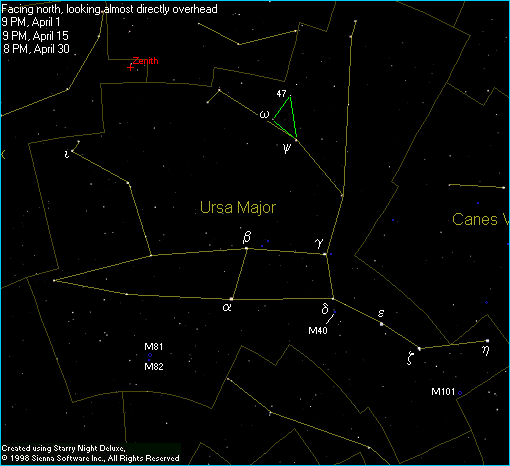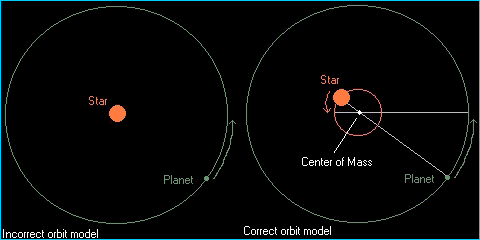


Ursa Major contains many double stars and deep sky objects for the small telescope owner to view, and the following suggestions are by no means a complete list! After taking a look at each of these, use a good star map to track down other interesting objects in Ursa Major or simply scroll your telescope around the sky. You will surely find many other interesting objects to look at! You can use the chart at right to help you find the objects described below.
Xi (x) Ursae Majoris [Double Star]: Xi is an interesting double star that can be best found by imagining a straight line from bright b Ursae Majoris to dimmer y Ursae Majoris. That distance represents about 13º. Continue that line straight on for about the same distance, and you'll arrive at two stars which are much dimmer than the two that guided you. Of these two dimmer stars, the one higher up in the sky at the times described on the chart is Xi.
Xi is a very interesting double star lying only 26 light years away. The primary star shines at magnitude +4.3, and you can currently find the magnitude +4.8 companion star about 1.6 arc seconds away at position angle 286º. The close separation means that you will probably need at least a 3.5 inch telescope under very good sky conditions to split this challenging pair.
But because this is one of the closest binary stars to us, the orbital motion of the components can be observed over the course of many years. As the years go by, the two stars orbit each other, resulting in a gradual change of the position angle and apparent separation of the two stars. The two stars orbit each other once every 60 years. Right now, the two have just passed their closest apparent separation which occurred in 1993. The separation will gradually increase in the coming years, and the position angle will be decreasing. By 2002, the companion will be about 1.8 arc seconds away from the primary star at position angle 260º, making it a little easier for a small telescope user to spy the two components. If you continue to watch this double star until 2035, you'll see the companion 3.1 arc seconds from the primary at position angle 115º...an easy target for any sized telescope! An interesting project would be to make an observation of this double on one clear, steady night each year or two to record the position angle and separation of the components. It's a great opportunity to observe the long term motion of the universe!
47 Ursae Majoris [Suspected Planetary System] This star is not particularly bright and it won't look much different through telescopes or binoculars than it does with your naked-eye, but I still think it's one of the most interesting objects in the sky! Lying about 46 light-years away and shining in our sky at only about magnitude +4.4, 47 Ursae Majoris (47 UMa) escaped mediocrity in 1996 when astronomers Geoffrey Marcy and Paul Butler announced that this Sun-like star shows strong evidence that it is orbited by a Jupiter-sized planet. The discovery of this and other possible "extrasolar" planets are giving astronomers their first real proof for what they've always believed -- that planetary systems are common around other stars.
Even with large professional telescopes, astronomers cannot directly see the planet in orbit around 47 UMa. This is because at the distance of 46 light-years, the dim planet appears too close to its much brighter sun to be seen. Since planets only shine by reflecting the light of their parent star, they appear about a billion times dimmer than the star! Now you may be wondering how astronomers can tell a planet exists when they can't see it. Astronomers can measure the "wobble" imposed on a star by an orbiting planet. Most people realize that the planets in a solar system are held in orbit by the star's gravity. The huge mass of the star pulls on each planet, holding them in place. But few people realize that the planets pull on the star as well! The result is that a planet doesn't really orbit its star in the way you may be used to envisioning. Instead, the star and the planets orbit a common "center of mass". The figures below show a simple example of this in a solar system with a star and one planet as viewed from above. In our own solar system, Jupiter's large mass dominates this effect on the Sun, and actually causes our Sun to trace almost a one million mile diameter orbit around the center of mass every 12 years. Observing our solar system from the side, the Sun would appear to slowly approach and recede on our line of site. This is the wobble that astronomers are looking for as a tell-tale sign of orbiting planets. Although a million mile wobble may sound easy to detect, it is actually very difficult when you consider the vast distance to the stars being observed. If you placed our Sun at 47 UMa's distance of 46 light-years, Earth bound observers would find that the million mile wobble that Jupiter causes would only appear equal to the width of a human hair viewed from 9 miles away!

47 UMA is very similar to our own Sun. Both are yellow dwarf stars with virtually the same mass, and 47 UMa is just slightly more luminous than the Sun. The suspected planet which may orbit 47 UMa is at least 2.4 times more massive than Jupiter and orbits the star once every 3 years from a distance of about 2 AU, which is just a little farther than Mars orbits our Sun. 47 UMa's planet wasn't the first one discovered orbiting a Sun-like star (51 Pegasi's suspected planet holds that honor), and several more extrasolar planets have been discovered since. But 47 UMa is unique in that the position of the Jupiter-sized planet resembles our own solar system more closely than the other planetary systems discovered.
You can find 47 Ursae Majoris by first finding magnitude +3.0 Psi (y) Ursae Majoris, well above the overturned bowl of the Big Dipper at the times shown on the star chart above. Imagine a straight line from bright Alpha (a) to somewhat dimmer Beta (b) UMa. That distance represents about 6º. Continue that line for about twice that distance to the next fairly bright star, which is y UMa. At the times on the chart above, 47 UMa is the next brightest star about 5º straight up from y UMa. Alternately, you can find 47 UMa by imagining the triangle formed by y, w, and 47 UMa outlined in green on the chart above. But remember, w and 47 UMa are rather dim stars which may be hard to find with your naked-eye if your sky suffers from a lot of light pollution. If that is the case, use binoculars to aid in your search.
Although you won't be able to see the planet orbiting 47 Ursae Majoris, it's fun to take a look at this remarkably Sun-like star anyway. For me, part of the fascination with astronomy is the idea that many of the stars I look at during an observing session actually harbor a complete solar system filled with planets both similar and drastically different from our own. Unfortunately, I could never tell which ones have planets. Well, here's one star that we can all point to and know with reasonable certainty that another planetary system exists there!
M81 and M82 [Galaxies]

M97 [Nebula]

M101 [Galaxy]

